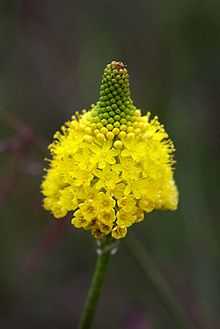Bulbinella
| Bulbinella | |
|---|---|
 | |
| Bulbinella triquetra | |
| Scientific classification | |
| Kingdom: | Plantae |
| Clade: | Angiosperms |
| Clade: | Monocots |
| Order: | Asparagales |
| Family: | Xanthorrhoeaceae |
| Subfamily: | Asphodeloideae |
| Genus: | Bulbinella Kunth [1] |
Bulbinella is a genus of plant in the family Xanthorrhoeaceae, subfamily Asphodeloideae.[2] Most species are endemic to South Africa, confined to the winter rainfall area with a few in New Zealand where they are most common in the central Otago region which enjoys a similar climate to the Cape Region of South Africa.
Description
They are characterised by the presence of a dense terminal raceme of flowers, often yellow but also white, pink, yellow or orange depending on the species. In the New Zealand species only species with white and yellow flowers occur. Each flower occurs in the axil of a bract and has 1 nerved perianth segments that are almost free. Each flower has 6 stamens. The seeds are characteristically shield shaped and there are one or two seeds in each chamber.
The plants may grow up to 1 metre in height and have narrow or thread like but never succulent leaves. The leaves decay into prominent fibres at the base of the stem, often netted or reticulate in appearance, although this feature is absent from the New Zealand species. They tend to overwinter and aestivate with wiry or swollen tubers.
Species
- Bulbinella angustifolia
- Bulbinella caudafelis
- Bulbinella divaginata
- Bulbinella elegans
- Bulbinella floribunda - Yellow Cat-tail
- Bulbinella gibbsii
- Bulbinella hookeri - Maori Lily
- Bulbinella latifolia
- Bulbinella modesta
- Bulbinella nutans
- Bulbinella punctulata
- Bulbinella rossii (Hook.f.) Cheeseman - Ross Lily
- Bulbinella talbotii
- Bulbinella trinervis
- Bulbinella triquetra
References
- ↑ "Bulbinella". International Plant Names Index. Retrieved December 29, 2009.
- ↑ Stevens, P.F. (2001 onwards), Angiosperm Phylogeny Website: Asparagales: Asphodeloideae